Small island communities are highly vulnerable to the impacts of climate change, with rising sea levels, intense storms, and coastal erosion threatening their way of life and livelihoods. Kunburudhoo Island in South Ari Atoll in the Maldives is one such community that has experienced significant loss and damage due to climate change, including beach erosion, salinization of groundwater, and loss of vegetation. Azeem, Ashraf, and Moosa, reflect not only on their own experiences but also share a depiction of lives of the island’s inhabitants and the limitations they encounter in their efforts to combat climate change.
Beach erosion
The susceptibility of small island communities, such as Kunburudhoo Island, to the impacts of climate change is evident through the significant erosion that has affected the island and its communities.
An Environmental Impact Assessment report prepared in 2009 noted that according to the community, the rate of erosion increased after an entrance channel was cut in the reef, and with the construction of the jetty at the southern side of the island in 1989. During this time coastal modification projects were completed without any Environmental Impact Assessments (EIAs). To protect from erosion, the community constructed breakwaters using jumbo bags (filled with cement), but soon realzied that these structures were not effective in combating the rate of beach erosion.
Beach erosion poses a serious threat to the stability and safety of the island’s infrastructure. The erosion has reached the edge of the island office, public water tanks, and homes . The report from 2009 indicated that if immediate mitigation measures were not taken, the eastern most houses would be lost due to erosion and associated impacts (Lamer, 2009). As part of a harbour building project, the government funded a fortification structure at the eastern side of the island to protect from beach erosion.
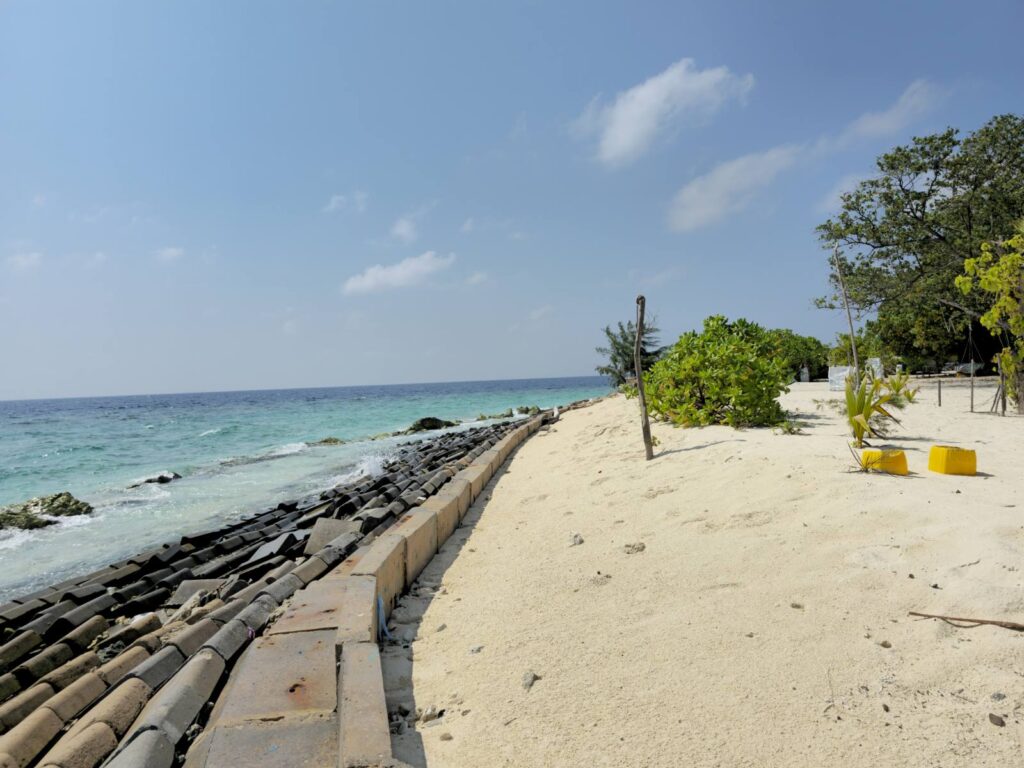
Ashraf
The island’s inhabitants have seen the loss of a beautiful beach that was once a source of joy for the community. Construction of the harbour meant that reef was dredged and there was no longer a beach. The fortification on the eastern side of the island also affected the look and use of the beaches.
“Beach erosion and harbour construction has deprived our community of the kind of beach it was before. Traditional activities and experiences such as swimming and spending leisure time at the beach are no longer the same for the younger generations,” says Azeem.
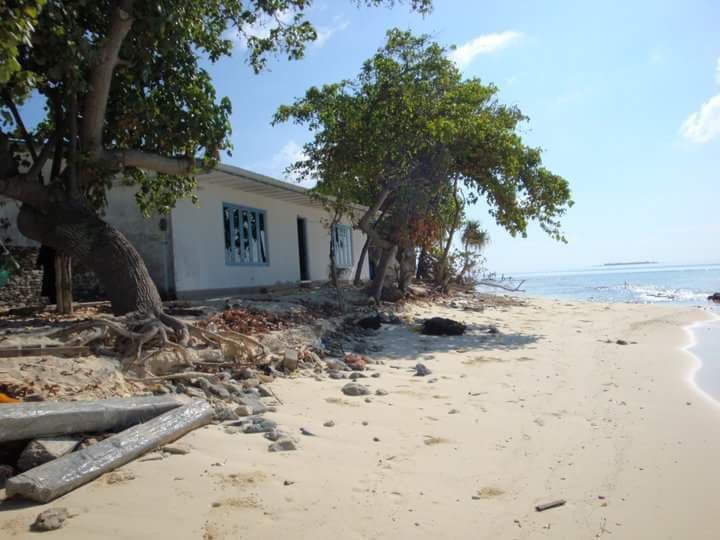
Ashraf
Salty water belongs in the ocean not in the groundwater
The island’s small size and vulnerability to beach erosion has also resulted in a significant impact on the island’s groundwater, making it salty and contaminated. A combination of swells from the sea, reduced freshwater, and increased groundwater extraction for household purposes has led to its contamination. As a result, the island’s residents are facing an accute potable water shortage. This has lead to increased financial burden, as they have to rely on bottled water for drinking and use rainwater that is collected for cooking.
Prior to the increased salinity intrusion, ground water was used for drinking and cooking. Now, it is only used for bathing and washing. Azeem explains that he feels a burning sensation in his eyes when he washes his face. The community has been enduring the problem of salnity intrusion for 20 years. The salty groundwater also damages washing machines and causes rust to build. While the government has been implementing projects to produce freshwater by converting sea water through reverse osmosis in various islands, such a project is yet to be implemetned in Kunburudhoo.
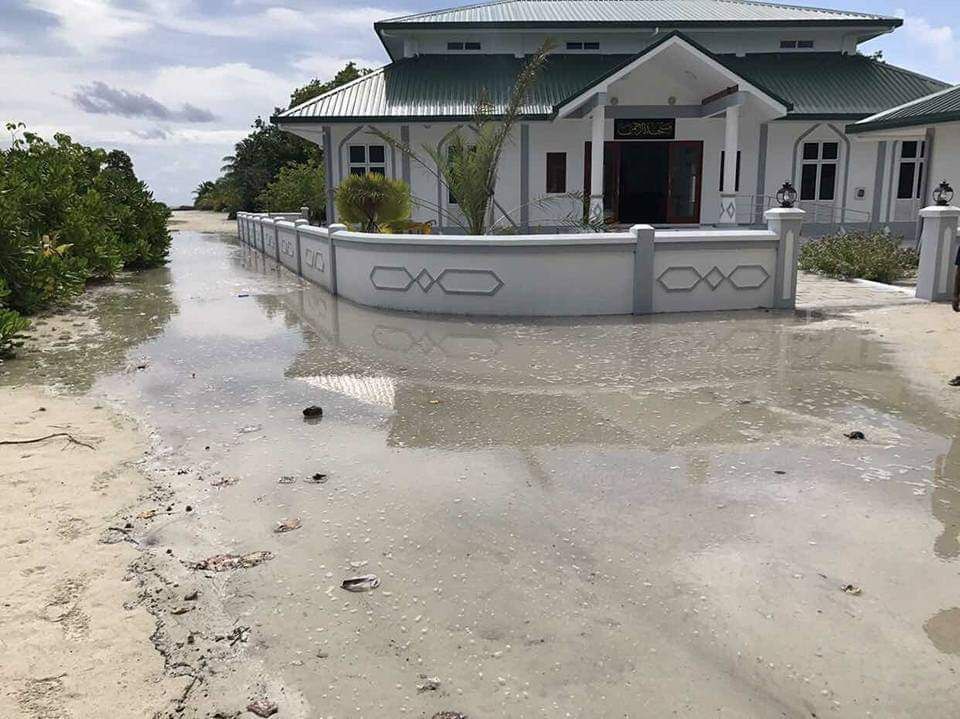
Ashraf
Traditional crops such as banana and breadfruit no longer grow easily either because of the salinization. This has led to a shift towards using more fertilisers and planting crops in pots. The population increase and housing constraints has put additional pressure on greenery and trees. Due to land constraints, no new plots have been allocated for housing for several years, which has led to trees being cut down to construct new houses in the already allocated plots.
Community efforts to combat losses and damages
Despite the challenges posed by climate change and land constraints, the community of Kunburudhoo Island has made efforts to address these losses and damages. One of the most prominent initiatives has been the planting of trees and coastal vegetation to combat beach erosion and protect against the impacts of salinization.
The community has been actively involved in tree planting, with households planting trees in their own compounds and participating in community-led efforts to plant trees in areas vulnerable to erosion. They have planted trees like coconut and beef wood, with many of them growing up to 15-20 feet in height.
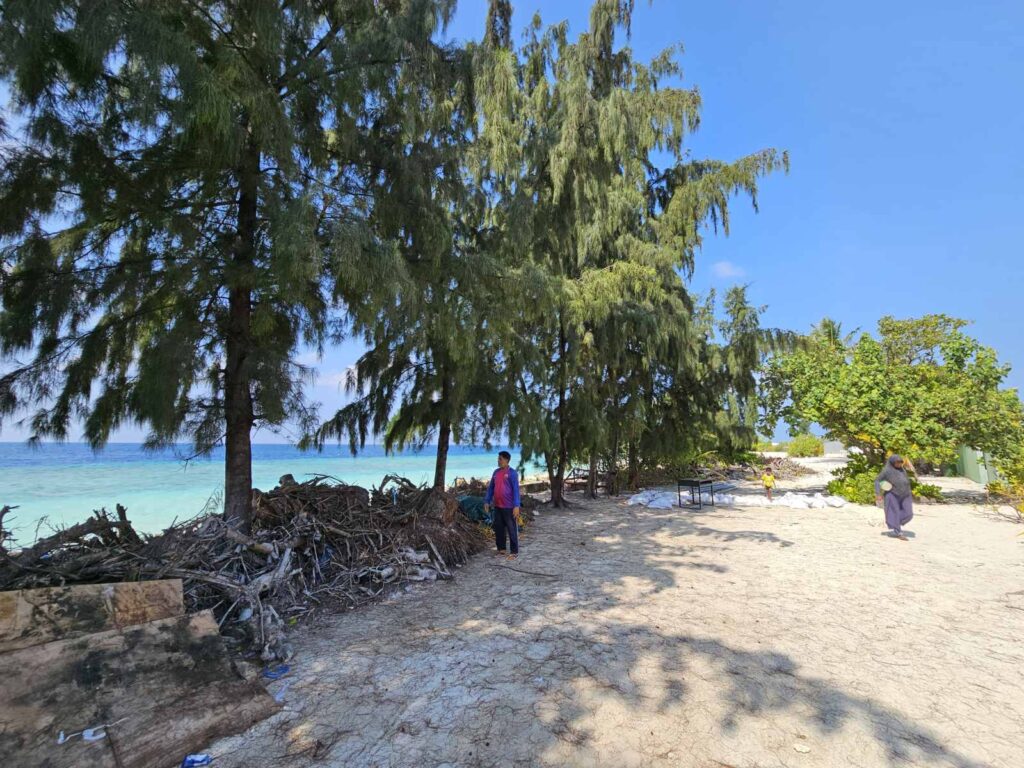
Ashraf
They also planted sea lettuce trees, which has been particularly effective in areas where erosion was severe, such as the stretch between the harbour and the mosque where the land is lower in elevation and there isn’t any shore protection.
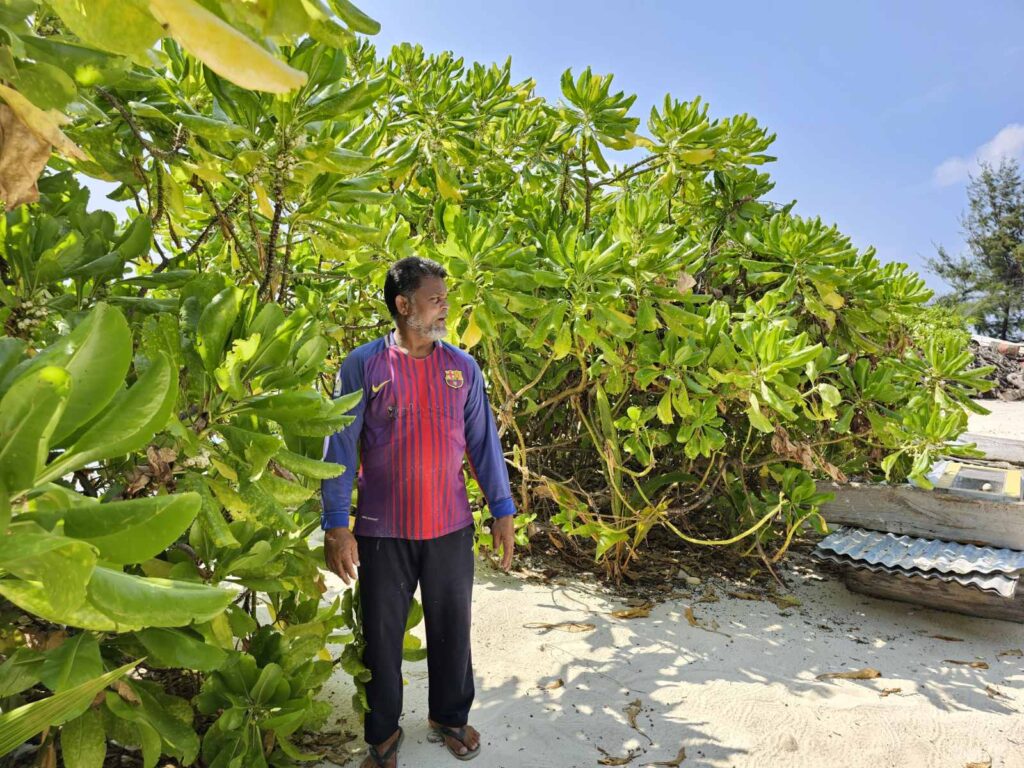
Ashraf
According to Ashraf, “the community made a collaborative effort to plant more trees than were lost. They planted about 250 coconut trees, which are particularly helpful in reducing erosion with their strong roots taking hold of rocks and strengthening the soil.” However, due to the small size of the island and land constraints, the tree planting has been limited, and erosion continues to pose a significant threat. Sea swells still occur, but the impact has been reduced.
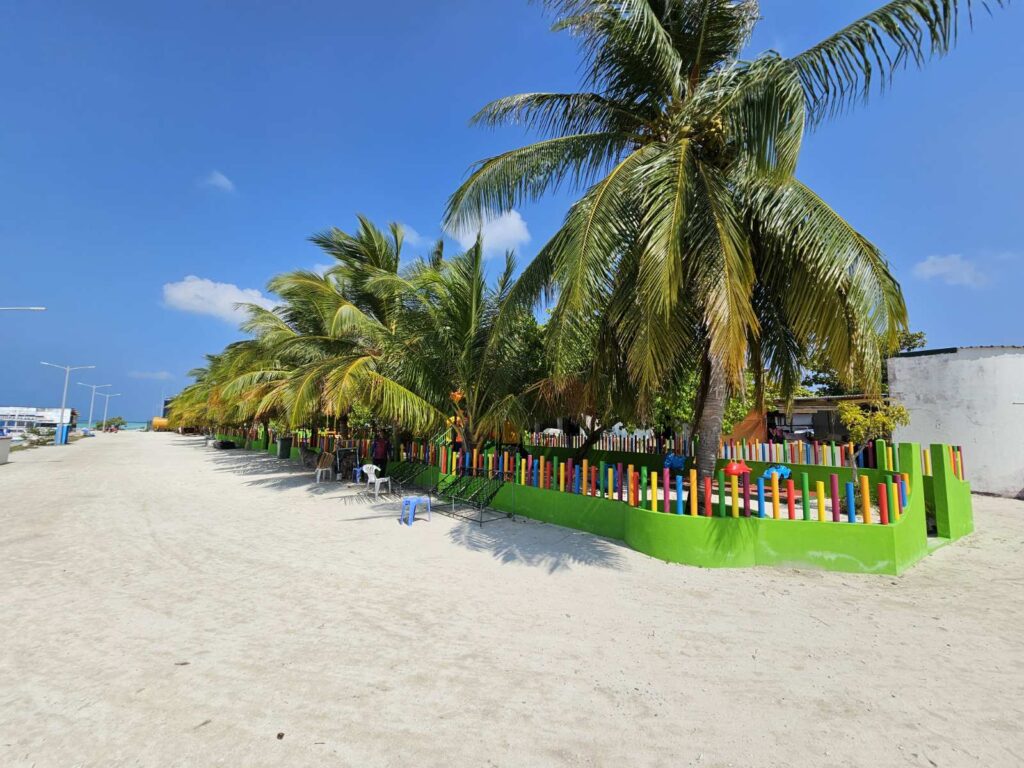
Ashraf
Loss of trees and loss of tradition
Coastal vegetation and trees provide shade and shelter for the island’s inhabitants, as well as an essential source of food and medicine. However, changes to traditional crops and the loss of knowledge associated with them has also affected the island’s culture. The tradition of sending fried breadfruit to family members, which was once an important part of their culture, has been interrupted due to the loss of breadfruit trees. These losses have affected the social and cultural identity of the island’s inhabitants. Coastal vegetation also played a crucial role in safety, providing a buffer against wind and waves that protects homes, farms, and infrastructure. Moosa, who actively participated in tree planting for coastal protection, stressed the importance of coastal vegetation for safety. He says, “coastal vegetation serves as a buffer against wind and waves, safeguarding homes and other buildings and infrastructure.” He highlighted the need for buffers to protect infrastructure, giving an example of how the lack of a coastal vegetation buffer caused the roofs of schools to be blown away by wind.
Interviewer’s perspective and way forward
It is clear that small island communities like Kunburudhoo Island need more support to mitigate the loss and damage caused by climate change. However, given the magnitude of the problem, there is a limitation to what small communities can do. The impact of climate change on the island and the limitations of the available land have made it difficult to fully mitigate loss and damage. Despite some success of community-led efforts, erosion and salinization remain ongoing challenges, and there is a need for continued research and investment in long-term solutions to protect small island communities like Kunburudhoo Island.
It is important to acknowledge that international institutes often use Gross Domestic Product (GDP) per capita as an indicator of a country’s resilience to climate change impacts. As a result, vulnerable communities in countries like the Maldives are often overlooked and under-supported. It is crucial that national and international efforts prioritise the needs of vulnerable communities and provide them with the necessary resources to adapt to the impacts of climate change. By recognising and addressing the challenges faced by small island communities, we can ensure that they are not left behind in the fight against climate change.
About the interviewer
Mohamed Shumais is a Maldivian PhD candidate from the Tech University of Korea. He also lectures in hybrid mode at The Maldives National University. His research interests focus on sustainable development in island communities.
About the interviewees
Azeem, previously worked at the island council and atoll council, now serves as a civil servant in the Ministry of Health.
Ashraf, a former island council worker, currently works at the island powerhouse.
Moosa, a skilled mason, played a key role in planting trees and coastal vegetation to protect against erosion and is actively involved in community development work.
All three interviewees share a passion for serving their community and have worked together with other community members on initiatives to address the impacts of climate change on their vulnerable island.
References:
BBC (n.d.) Coastal Landforms, British Broadcasting Corporation,
https://www.bbc.co.uk/bitesize/guides/z8tstv4/revision/6
Edwards, A. J., Clark, S., Zahir, H., Rajasuriya, A., Naseer, A., & Rubens, J. (2001). Coral bleaching and mortality on artificial and natural reefs in Maldives in 1998, sea surface temperature anomalies and initial recovery. Marine Pollution Bulletin, 42(1), 7-15.
Land and Marine Environmental Resources Group. (2010). Environmental impact assessment report harbour development works at Rashdhoo, Alifu Alifu Atoll. Male’: Maldives